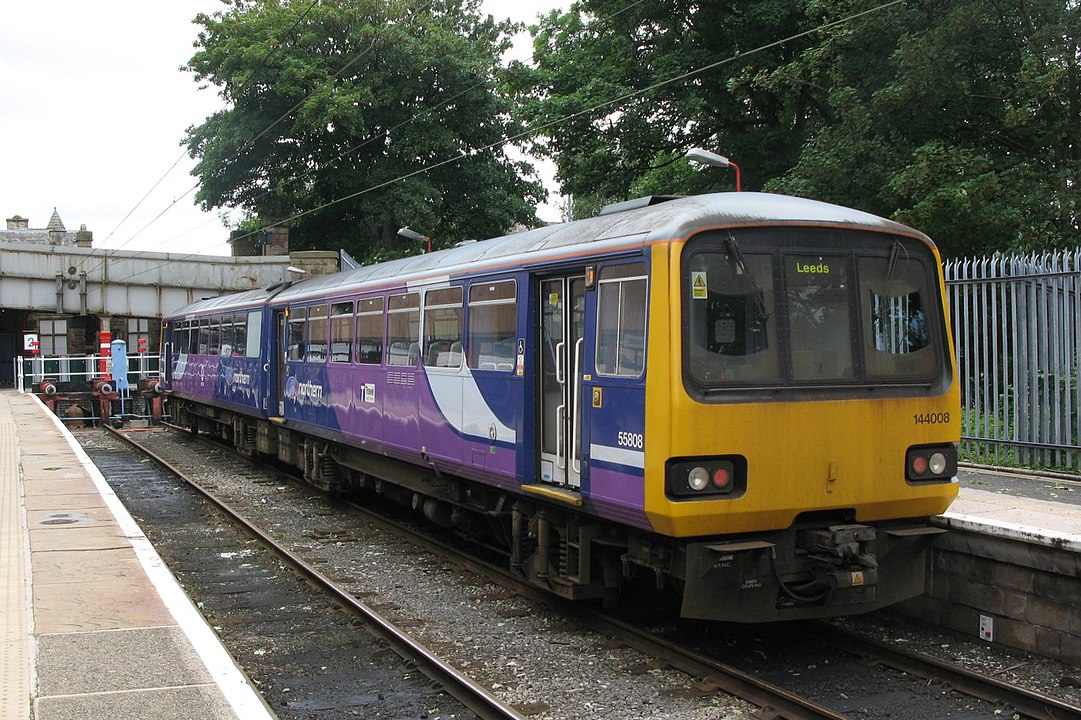Class 142
On this page
Specification table & more images at bottom of page
Est. reading time:
Page Settings
Font:
Font Weight:
Text Size:
Width:
Create an account for enhanced personalisation!
Search Wiki
The Class 142 Pacer is a type of diesel multiple unit which was constructed from 1985 to 1987 for British Rail. The type is part of the 'Pacer' family of railbuses, and shares many parts with the Leyland National bus. The last unit was withdrawn from service in 2020.
.jpg)
Arriva Trains Wales Class 142 at Cardiff Central in 2016
Background & History
By the beginning of the 1980s, British Rail (BR) operated a large fleet of first-generation diesel multiple units (DMUs), which had been constructed in prior decades to various designs. While formulating its long-term strategy for this sector of its operations, British Rail planners recognised that considerable costs would be incurred by undertaking refurbishment programmes necessary for the continued use of these ageing multiple units, particularly due to the necessity of handling and removing hazardous materials such as asbestos. In the light of the high costs involved in retention, planners examined the prospects for the development and introduction of a new generation of DMUs to succeed the first generation.
Advertisement
In the concept stage, two separate approaches were devised, one involving a so-called railbus that prioritised the minimisation of both initial (procurement) and ongoing (maintenance & operational) costs, while the second was a more substantial DMU that could deliver better performance than the existing fleet, particularly when it came to long-distance services. While the more ambitious latter requirement would ultimately lead to the development of the Class 151 and the wider Sprinter family of DMUs, BR officials recognised that a cheaper unit was desirable for service on the smaller branch lines that would not be unduly impacted by lower performance specs or a high-density configuration. Work to progress both approaches was therefore undertaken by BR's research department during the early 1980s.
During this period, a number of prototypes were constructed to explore different designs and approaches for implementing the railbus concept. One such vehicle was a single two-car unit, designated Class 140, built between 1979 and 1981. This prototype was introduced with much fanfare in June 1981. Initial testing with the Class 140 uncovered several problems, such as difficulty detecting the type via track circuits. This was reliably resolved by changing the material of the brake blocks from a composite to iron. Two less easily addressable drawbacks were the high level of noise generated during transit, particularly on older jointed rails, a consequence of the railbus's direct connection between the underframe and suspension with the body that transmitted impact forces across the body. It was also observed that the inclusion of strengthening members in the mass-produced bus body added significantly to the overall production cost, which eliminated much of the cost advantage that was the primary goal of the type.
Advertisement
The Class 140 was deemed an overall success, so BR issued an order for an initial production model, designated Class 141, to British Leyland during 1984. During its early years of service, the Class 141 experienced numerous problems, particularly with the transmission and ride quality; work undertaken by BR resulted in the quick development of numerous improvements to at least partially address these shortcomings. When it came to ordering more railbuses, however, it was decided that instead of placing these follow-on orders for further Class 141, it would be more desirable to procure improved derivatives of the Class 141. Accordingly, BR placed orders for two new models of the Pacer family with separate manufacturers, these being the Class 142 and the Class 143.
Design
The Class 142 shared a high degree of similarity to the design of the Class 141. However, one major area of change is that both the Class 142 and Class 143 featured a noticeably wider body, instead of adhering to the width of the standard bus as per the Class 141; specifically, the width was expanded to the maximum amount permissible to remain within the loading gauge. This resulted in an increased internal area to accommodate passengers within, enabling a three-by-two seating arrangement to be installed for a total maximum capacity of 121 seats per set. The increased seating was particularly useful as, in addition to their use on rural feeder services, the Class 142's use on short range urban services had been foreseen by BR planners. Each unit has a seating capacity of between 102 and 121 passengers per two-car set.
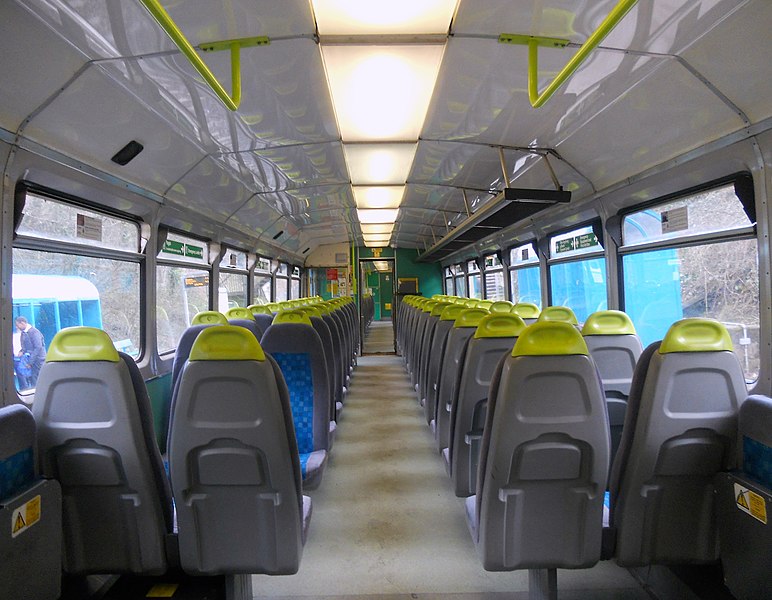
Interior of an Arriva Trains Wales Class 142 in 2013
Both the bodies and underframes were designed for interchangeability, as had been specified by BR. To achieve this, they were manufactured upon jigs. They had been designed so that the entire body could be replaced during a mid-life refurbishment/reconstruction, and that the replacement body would not be limited to the exact same dimensions either. The underframe area, in addition to its structural role, accommodated all of the propulsion apparatus along with the majority of electrical gear. As a cost-saving measure, the manufacturers were directly to make use of road bus-standard equipment in several areas, including passenger fittings and the general cab layout, along with other areas wherever possible; Unlike the Class 141, which featured automotive-standard wiring for the traction equipment with resulting poor performance, railway-grade wiring for the traction and braking circuits was mandated by BR for both the Class 142 and Class 143 to yield greater reliability.
Advertisement
As originally built, the traction arrangement of the Class 142 consisted of a Leyland TL11 200 horsepower (150 kW) engine, a Self-Changing Gears mechanical automatic gearbox and a Gmeinder final drive unit on each car driving only a single axle. This propulsion arrangement was in part taken from the Leyland National bus, as well as shared with the earlier Class 141. Unlike the Class 141, a microprocessor-based controller for the automatic transmission was used from the onset, allowing the reliability issues posed by defective relay logic and poor earthing present on the predecessor to be entirely avoided. Another improvement was the installation of auto-couplers and auto-connectors that enabled the Class 142 to work in multiple with the Class 150 Sprinter DMUs. The Class 142 is fitted with double-folding external doors, identical to the preceding Class 141. Each car has a fuel capacity of 125 imperial gallons (570L).
Both axles (one driving per coach at the inner end) were fitted directly to the chassis rather than being mounted on bogies, unlike traditional DMUs. This uncommon arrangement has been attributed with resulting in the Class 141 units possessing a relatively rough ride, especially when traversing jointed track or points. Their comparatively poor ride quality has been said to be a major factor in the type's general unpopularity amongst passengers. As a positive result from BR's experiences with the Class 141, the Class 142 featured an improved suspension arrangement to enhance passenger comfort, this consisted of a wider spring base and double dampers being installed, features that had been deemed necessary by BR to provide sufficient levels of performance, and had been retrofitted onto all of the older Class 141s as well.
Excessive flange squeal on tight curves has been a problem on many routes operated by the Class 142 – this is caused by the long wheelbase and lack of bogies.
Refurbishment
Starting in the early 1990s, every member of the class was mechanically upgraded due to the original parts starting to fail. Accordingly, each car was refitted with a more powerful Cummins L10 series engine – 230 bhp (170 kW) per car, which equals 460 bhp (340 kW) per twin-car unit – and Voith T 211 r two-stage hydrokinetic transmission, starting with a torque converter which switches to fluid coupling drive once the unit is up to 45 mph (72 km/h). All units were fitted with new Voith transmission by late 1991 and Cummins engines were fitted between 1993 and 1996 to improve reliability. This change has proven to have been largely successful, although isolated failures have occurred, such as when a Northern Rail unit derailed en route from Blackpool to Liverpool in June 2009 due to a cardan shaft failure.
Operations
British Rail Provincial/Regional Railways
From new, some units were painted according to the region they operated in. For example, the first 14 Greater Manchester Passenger Transport Executive sponsored units (142001-014) received GMPTE orange and brown, then the next 13 West Country based units (142015-027) were painted in a Great Western Railway inspired chocolate and cream livery and marketed as 'Skippers'.
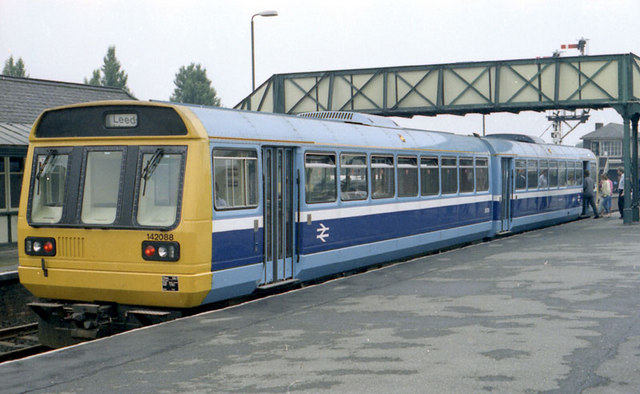
Class 142 in the original British Rail Provincial two-tone blue livery at Castleford in 1987
Post Privatisation
Northern England:
Upon the privatisation of British Rail, the Class 142 fleet was divided between North Western Trains in the North West and Northern Spirit in the North East.
Northern Spirit began operations in 1997 and continued until 2000. At this point, parent company MTL ran into difficulties and the company was sold to Arriva, who renamed it Arriva Trains Northern in 2001.
In 1998, ATN swapped seven Class 142s (142085-142091) for seven Class 150/2 units from Valley Lines. In October–December 2002, these were swapped for non-refurbished units 142072-77 and 080–3, as 142086-091 had only recently been refurbished by Northern Spirit and Valley Lines wished to start their refurbishment from scratch.
In 2004, First North Western and Arriva Trains Northern were merged into the Northern rail franchise, which inherited a combined fleet of 79 Class 142s.
Advertisement
All 79 Class 142s were painted into the Northern Rail livery. Due to rising passenger numbers in the north of England (by about 10% per annum and even by over 25% per annum at some stations where the 142s were in operation), some units had been replaced by Sprinter trains.
Five Class 142 Pacers, in service with First Great Western, were returned to Northern Rail in December 2008. The rest returned to Northern Rail by November 2011, much later than originally planned.
Despite being built for branch-line stopping services, the Class 142s were mainly used on urban commuter services in and out of cities like Liverpool, Manchester, Sheffield, Leeds and Newcastle, and were seen on longer-distance services of up to three hours including the 1632 Middlesbrough-Carlisle service – nearly 110 miles (180 km); they had also been used on services between Blackpool North and Chester via Stockport, which ceased to operate in December 2008. All 79 passed with the Northern franchise to Arriva Rail North in April 2016, and any remaining units transferred to the government-owned operator Northern Trains on 1 March 2020.
In June 2020, it was announced that 13 Class 142s would be allowed to re-enter service if necessary, the units being 142004, 018, 023, 058, 065, 068, 070, 071, 078, 087, 090, 094 and 095, which they did on 6 July 2020 following the introduction of a new timetable, due to a need for extra capacity for social distancing during the COVID-19 pandemic, coupled to Class 150s so as to avoid needing to be non-PRM (persons of reduced mobility) modified.
Pacers were withdrawn from Northern Trains on 27 November 2020, the last service being the 16:36 Kirkby to Manchester Victoria, operated by 142004.
Merseyside:
A total of seventeen Class 142 units based at Newton Heath TMD (142041-049 and 142051-058) were refurbished for use on Merseyside Passenger Transport Executive's City Line on services around the Liverpool and Greater Manchester areas. The refurbishment included dot-matrix route indicators and a new design of individual low-backed seating, and the trains were repainted into Merseyrail's livery.
Upon privatisation, these units passed to First North Western in March 1997. All of these sets were transferred to Northern in 2016, however remained in the livery of previous operator Northern Rail.
Wales:
Valley Lines acquired its Class 142s by swapping Class 150/2 units with Arriva Trains Northern. The Class 142s were initially painted in Valley Lines livery.
Transport for Wales used its Class 142 Pacer trains on the commuter lines around Cardiff, Barry and Penarth known as the Valley lines. All of its Class 142 Pacer fleet wore the turquoise and cream house colours of Arriva Trains Wales. The Class 142 units were also primarily used on South Wales Valley line routes and routes through the Vale of Glamorgan. On Valley and Vale of Glamorgan services, Class 142s were often coupled together with Class 143 or Class 150 units to cope with demand on the busy Valley Lines network. The Class 142s received minor refurbishments with retrimmed seats in new moquette, plus the installation of ceiling-mounted CCTV cameras.
South West England:
Twelve Class 142 Pacers were received by First Great Western in 2007, and started operations in December 2007. These were loaned from Northern (where they had been stored), in part to cover for the refurbishment of FGW's Sprinter fleets but also to allow the Class 158s to be reformed as three-coach sets.
The 142s were based at Exeter TMD, working alongside the similar Class 143s on services in Devon and Cornwall, including the Avocet Line, Riviera Line and Tarka Line.
Five 142s were returned to Northern Rail in the autumn of 2008, following the completion of the refresh of Class 150 Sprinter units. The remaining seven units were returned to Northern Rail in November 2011 after being replaced by class 150 units cascaded from London Overground and London Midland.
Withdrawal
All 94 Class 142s were to be withdrawn by mid-2020, as they did not comply with the Persons with Reduced Mobility Technical Specification for Interoperability (PRM-TSI).
Bidders for the Northern franchise that commenced in April 2016 were required to order new DMUs and take on Sprinters and Turbostars (Classes 150, 156, 158 and 170) released by other franchises as replacement. The Long Term Passenger Rolling Stock Strategy for the Rail Industry indicates up to 500 non-electric carriages will need to be built in the short term. Arriva Rail North withdrawals were scheduled to commence in November 2018 with the last to be removed from traffic in October 2019. This was slightly delayed until the first Class 195 entered service.
Wales & Borders franchise holder KeolisAmey Wales planned to replace all of its Class 142s by mid-2020.
Advertisement
In August 2019, Arriva Rail North retired seven and placed them in store at Heaton TMD. Scrapping commenced in December 2019 with 142005 taken to CF Booth, Rotherham. In December 2019, three withdrawn Arriva Rail North units were transferred to Transport for Wales for spare parts.
In December 2019, both Arriva Rail North and Transport for Wales were issued derogations to allow use into 2020. Northern Trains was permitted to operate the units until 31 May 2020, but only when coupled to a compliant unit, while Transport for Wales was permitted to use the units until 31 July 2020 and could be operated alone. This was later extended to 31 December 2020 for both operators.
The final Class 142s were withdrawn from Northern Trains in November 2020 and Transport for Wales in December 2020.
Accidents & Incidents
Two Class 142 units were withdrawn through accident damage. The first of which was unit 142059, which was withdrawn in 1991 after colliding with a buffer stop at Liverpool Lime Street. The train had run away down the hill from Edge Hill whilst returning with brake problems. The train was running without passengers at the time and the driver and guard both survived the accident without serious lasting injury. The platforms were evacuated in time before the train struck the buffers.
The most serious accident involving a Class 142 was at Winsford in 1999. The driver of Class 142 No. 142008 operated by First North Western, running empty from Crewe to Liverpool Lime Street overran a red signal on the slow line and stopped in the path of the 06:15 London Euston to Glasgow Central Virgin Trains express, hauled by a Class 87 electric locomotive, No. 87027 Wolf of Badenoch. The impact, which caused the unit to be written off, severed the Pacer's body from its frames and caused severe internal damage. 27 people were injured, 3 seriously.
Other incidents involving Class 142s include:
- On 11 June 2009, a Class 142 (No. 142042) operated by Northern Rail derailed while en route from Blackpool to Liverpool. All but one of the 40 passengers on board escaped injury. An initial investigation was carried out by the Rail Accident Investigation Branch which determined that the engine mounted under the rear coach became detached and fell onto the track at a recorded speed of 57 mph, derailing the rear axle. The detachment of the engine caused extensive damage to underfloor equipment, severing control wires and damaging the braking system resulting in an automatic emergency brake application. Problems with engines on 142s have been experienced before.
- On 8 August 2009, Arriva Trains Wales unit 142069 derailed during an empty stock movement at Rhymney, South Wales. The unit was preparing to work a morning service with 143625 when it derailed on a set of points and hit the platform edge. 142069 was later removed by road to Cardiff Canton depot and fears were raised that the frame might have been damaged beyond repair. These fears proved unfounded and the unit later returned to service.
- On 3 October 2009, a unit of the class collided with another train at Darlington.
- On 4 January 2010, unit 142029 collided with a train comprising two Class 159 diesel multiple units at Exeter St Davids. Nine people were injured.
- On 10 April 2011, a cardan shaft failure on 142045 led to an incident at Durham, injuring a member of the public with a piece of ballast kicked up by the detached shaft.
- On 27 April 2012, unit 142091 was working the 1125 Lincoln – Adwick service when it hit a landslide after exiting Clarborough Tunnel near Retford causing major frontal damage to the unit. Two people were taken to hospital with minor injuries, one of these being the driver. The landslide was blamed on heavy rain and poor drainage. The unit has since returned to service.
- On 4 October 2016, unit 142072 caught fire at Caerphilly.
- On 9 October 2018, unit 142086 derailed at Sheffield station.
Preservation
Several operational Class 142 units have made it into preservation and additional sets are set to be saved/earmarked for preservation, most of which so far being ex-Northern operated units with one being an ex-Arriva Trains Wales unit.
The pioneer Class 142 Unit, 142001, is part of the National Collection and preserved at the National Railway Museum Shildon. Other select units have also been purchased but will only be used to provide spare parts to the units which are planned to operate on heritage railways or museums.
Class 142
| Type | Diesel Multiple Unit |
|---|---|
| In service | 1985–2020 |
| Manufacturer |
British Rail Engineering Limited Leyland Vehicles Limited |
| Built at | Derby Litchurch Lane Works |
| Family name | Pacer |
| Constructed | 1985–1987 |
| Refurbished |
1997–2003 2008–2017 |
| Number built | 96 |
| Number preserved | 35 |
| Number scrapped | 60 |
| Formation | 2 vehicles per unit: DMS-DMSL |
| Capacity | 102 to 121 seats |
| Car body construction | Steel |
| Car length | 15.123 m (49 ft 7.4 in) |
| Width | 2.800 m (9 ft 2.2 in) |
| Height | 3.863 m (12 ft 8.1 in) |
| Doors | Double-leaf folding (3 per side) |
| Wheelbase | 9.000 m (29 ft 6.3 in) |
| Maximum speed | 75 mph (121 km/h) |
| Prime mover(s) (As built) | 2 × Leyland TL11 |
| Prime mover(s) (After upgrade) | 2 × Cummins LTA10-R (one per vehicle) |
| Engine type | Inline-6 4-stroke turbo-diesel |
| Displacement |
Leyland: 11.1 L Cummins: 10.0 L per engine |
| Power output |
Leyland: 149 kW (200 hp) Cummins: 168 kW (225 hp) per engine |
| Transmission (As built) | SCG RRE5 (4-sp. epicyclic) |
| Transmission (After upgrade) | Voith T 211 r (hydrokinetic) |
| Braking system(s) | Electro-pneumatic (tread) |
| Safety system(s) |
AWS TPWS |
| Coupling system | BSI |
| Multiple working | Within class, and with Classes 14x, 15x, and 170 |
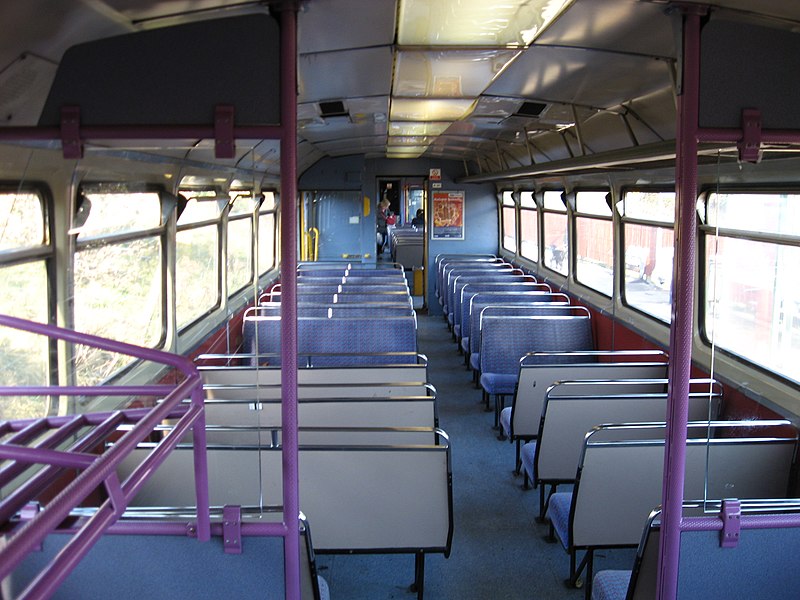
The interior of a refreshed First North Western Class 142
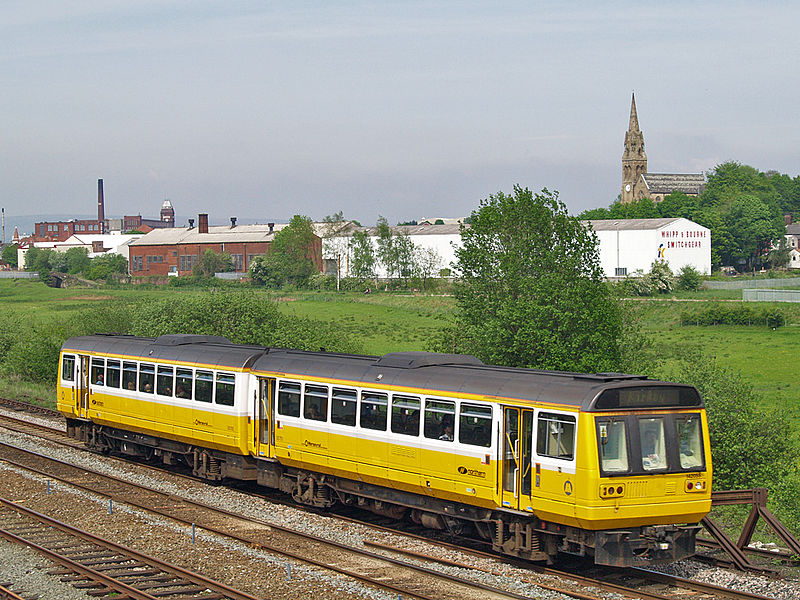
A Class 142 in Merseyrail livery
See also
Last updated 11 July 2024. All information and images sourced from the relevant Wikipedia article(s) unless stated otherwise. If any information is incorrect, please let us know by emailing us: [email protected]. Text is available under the Creative Commons Attribution-ShareAlike License 4.0; additional terms apply.

